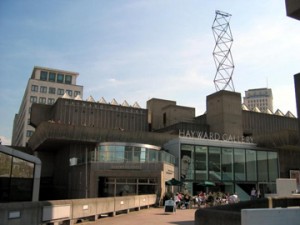London’s Hayward Gallery re-opened to the public this past Saturday with two new exhibitions. Headlining is The Edges of the World, a solo show by the Brazilian artist Ernesto Neto, who has been given the gallery’s upper rooms and outdoor sculpture gardens to exhibit his site-specific installations. Neto also features in the Hayward Gallery’s second show, a group exhibition entitled The New Decor, where the role of interior design is explored through the works of thirty contemporary artists. Together, these exhibitions form a part of the Festival Brazil season currently underway across the Southbank Centre, comprising the Hayward Gallery, Royal Festival Hall, Queen Elizabeth Hall, Purcell Room, and Poetry Library.
Having closed for six months for essential and non-essential repair and renewal, the gallery has re-opened with changes including a refurbishment of the foyer and gift shop, new entrance doors to the gallery and sculpture gardens, renewal works to the ceilings, floors and toilets, an upgrade to the ongoing maintenance systems and the building of new staff offices. Timing is everything.
For the past ten years, the Southbank Centre has been undergoing consistent and necessary redevelopment and modernization. This has resulted in both small-scale and major improvements, including new waterside frontage, the two-year refurbishment of the Royal Festival Hall itself, and a new extension building for office staff. In the two years until London plays host to the Olympic Games, the cultural legacy for the anticipated waves of increased tourism is expected to be well provided for, not least on the south bank of the River Thames, where along a couple-mile stretch of land, you can walk between the London Aquarium, the London Eye, the Southbank Centre, the British Film Institute, the National Theatre, and Tate Modern. Timing is everything.
The Hayward Gallery welcomed back its audiences the day after Arts Council England, the national development agency for the arts, announced how they intended to make the £19 million worth of immediate in-year cuts as demanded by the new coalition government. The bulk of the money (£9 million) will be drawn from Arts Council England’s emergency reserves and only £1.8 million will come from a cut in the funding that Art Council England provides to its regularly funded organizations (RFOs), equivalent to a 0.5% decrease in one of each RFOs quarterly payments. Comprised of the above cultural venues, the Southbank Centre is equivalent to one of the three largest RFOs in the country, alongside Arts & Business and the Royal Opera House. The 0.5% cut has been met with a small sigh of relief and it is undoubtedly a gesture by Arts Council England; there are lean times ahead.
George Osborne MP, Conservative Chancellor of the Exchequer in the United Kingdom’s new coalition government, will unveil on Tuesday 22nd June an emergency budget designed to introduce £30 billion worth of austerity savings and tax hikes for economic stimulus. Arts Council England is currently settling into a new structural mode of working practice. Following a series of reviews in 2008 leading to an organizational restructure to save £6.5 million of administrative costs, it saw the loss of approximately 30% of jobs in April of this year. Details of Osborne’s emergency budget are slim at the moment, but the arts are not expected to figure highly in the government’s plans. In the autumn, Arts Council England will hold a comprehensive spending review with the government in order to renegotiate funding levels for the years 2011-14. It is expected that this will be when the agency is forced to show its teeth. A review of the RFO portfolio has been ongoing for almost nine months and there will be organizations that lose publicly-funded status.
Timing is everything. It will prove difficult for large-scale refurbishment and capital projects to attract funding in the coming months and years, even if the fruit of the emergency budget is a definitive exit from the recession and sustained economic growth. Other projects, intended to expand London’s already significant cultural sector, will also be curtailed. It was expected in the original plans for the behemoth Tate Modern 2 for the opening to coincide with London 2012. However, with only a third of the £215 million budget as of yet in place, it seems that the only part of the design that will be complete will be the refurbished oil tanks of the former power station. A few minutes walk from Tate Modern, neighboring the Hayward Gallery, £45 million promised by the previous British government to the British Film Institute towards the cost of a BFI Film Centre has been rescinded. Ed Vaizey, the Conservative Culture Minister who heads the state department for culture, the Department for Culture, Media and Sport, will have a difficult task in persuading budding philanthropists of the value of the arts when his party will be stealthily removing the reliance on the government funding towards artistic development. It is hoped that London 2012 will have an effect similar to that of the Festival of Britain in the post-war United Kingdom, when, in fact, the South Bank cultural site was constructed. “A tonic for the nation” was how Herbert Morrison, then-Deputy Prime Minister for the Labour government, described his concept and it proved a massive commercial success. The timing was everything and austerity was definitely not on the cards.





Pingback: An unlikely gift horse | Art21 Blog